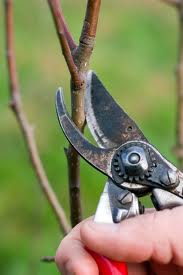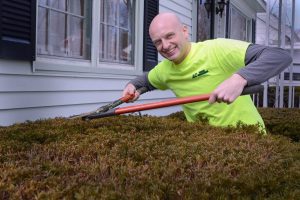Pruning is when you selectively remove parts (branches, stems and flowers/buds) from plants, shrubs and trees. While pruning certainly improves the shape and style of a plant, it also serves other important purposes. Pruning improves a plant’s structure and controls new growth making the plant healthier. Pruning also removes dead, damaged or diseased stems and branches, and encourages the development of flowers, fruit, and new foliage.
There are many benefits of pruning:
- Improves the overall look and shape of the tree, shrub or plant.
- Removes dead, broken or sickly branches that are sapping the plant’s energy.
- Protects your property; keeps you, visitors and your property safe.
- Encourages new, healthy growth.
- Trains the plant to grow where and how you would like, such as away from your roof and sides of the house, away from power lines, etc.
- Improves the structure and strength of the plant.
- Enhances your whole landscape.
When to Prune
When to prune depends on the plant in many cases. Flowering plants and shrubs can be finicky, and pruning at the wrong time can ruin next year’s flower production. Spring is often a preferred pruning time, but fall is an excellent time to prune back trees and shrubs before winter.
What to Prune
Less is more when it comes to pruning, especially if you’re a novice. Don’t prune recklessly, and stand back regularly to check your work. The most common mistake people make is over-pruning. Once it’s cut, it may never look the same again, so be slow and intentional for the best results.
Start with Dead, Dying, Broken or Diseased Branches
The best place to start is with branches that are dead or dying. This can be done at any time of the year. Diseased branches should be pruned immediately to protect the rest of the plant from infestation. Areas of a flowering plant that no longer produces flowers can also be removed. Pruning damaged areas saves the plant’s energy to focus on healthy and new growth for a better looking plant.
Other Areas to Prune
After removing the dead and dying areas, remove:
 Double-Crossed, Inward and Downward Branches will rub and chafe each other and other main, healthy branches, and should be removed.
Double-Crossed, Inward and Downward Branches will rub and chafe each other and other main, healthy branches, and should be removed.
Suckers that grow out of the base of the plant or from the roots should be removed close to the source. Bushes such as lilacs could be an exception to this rule, depending on your goal for them.
Water Sprouts are shoots that grow straight up from the main branches of shrubs and trees. Removing them right away helps to guide the shape and growth pattern of a tree or shrub, and prevents branches from overlapping and chafing.
Pruning to Renew the Plant
Once pruning is completed for the overall health of the plant, shrub or tree, there are types of pruning that renew the plant for a stronger, healthier shape and size.
To Prune Requires Skill
There is a definite art to pruning that takes time to develop. You can certainly experiment and learn as you go, but do some research and planning before you attack with pruning shears or the saw. Research the best way to prune specific plants. For flowering shrubs, for example, there are certain times to prune them, depending on your goals. By knowing your tree, shrub or plant, its purpose, and especially when it blooms, you will be able to prune it correctly for happy, healthy plants.
Fall is the prefect time to prune and get your shrubs and trees ready for winter and healthy spring growth!
Call AC Yard Services for Your Pruning Needs
Schedule us now for fall pruning. It’s the perfect time to assess what shrubs, trees and other plants in your yard are overgrown or in need of shaping. Pruning in the fall prepares the plant for winter and will encourage healthy new growth this spring.
